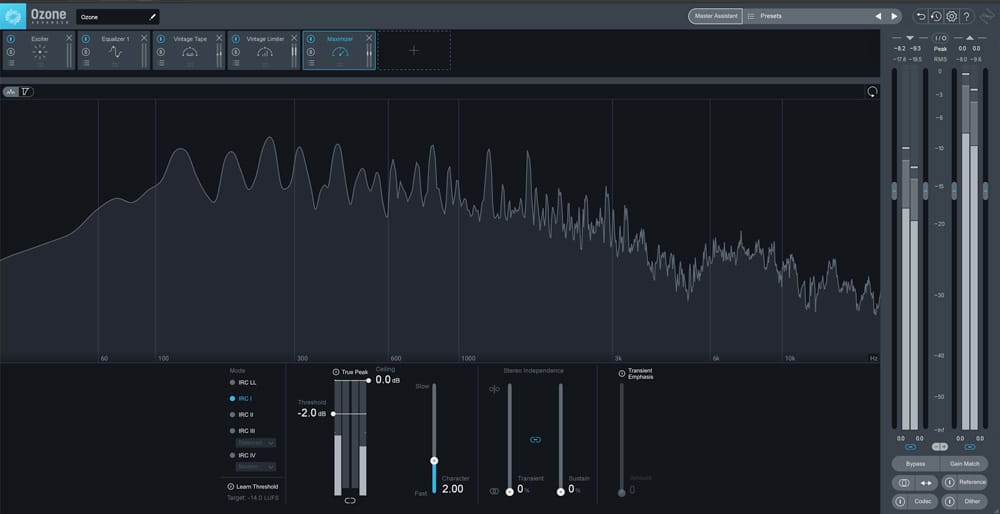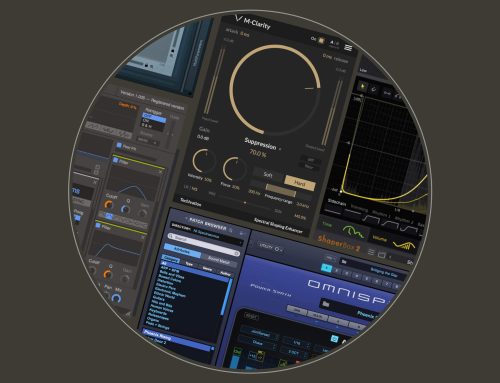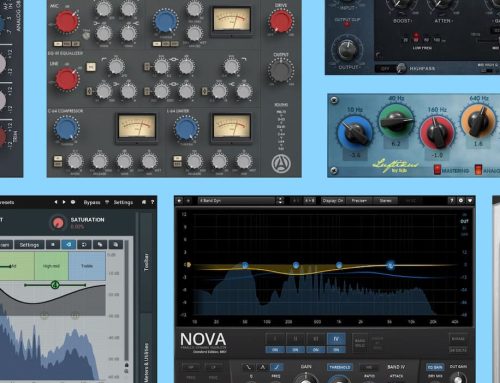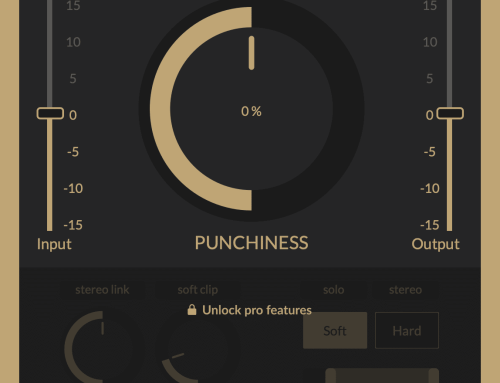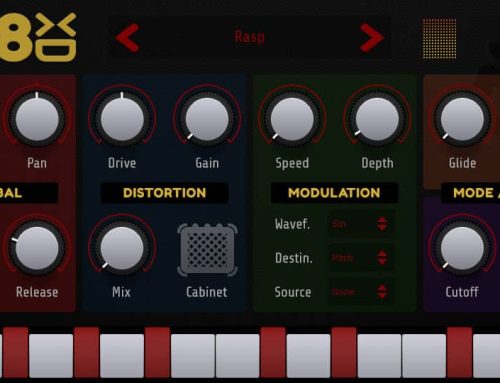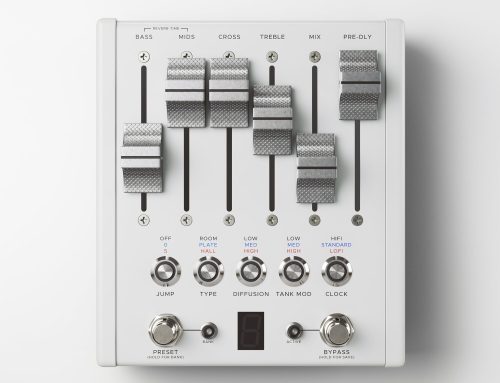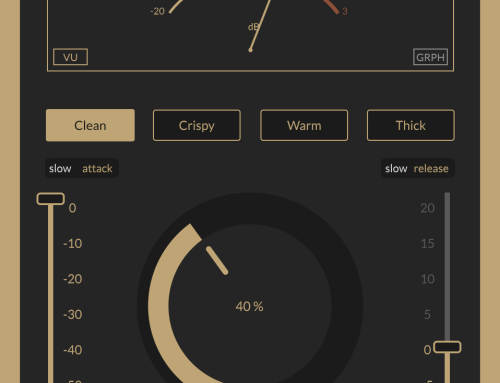By Ivo Sotirov
As the world embraces AI and machine learning so does iZotope with their 9th edition of Ozone. In September 2019 this mastering suite introduced new features like Tonal Rebalance as well as a Low-End Focus module yet efficiency went up with lower power consumption and faster loading times. Now, a year later, the dust has settled, and we are here to test the Ozone’s new features.
What is Ozone?
Founded in 2001, the US giant software developer iZotope caters to nearly every music-making or processing sector of the industry. They have developed individual packages of plugins that serve the needs of people operating in Recording, Mixing, Mastering, Music Production, and Sound Design environments. Having nearly 20 years of experience and time to perfect their products, every single one of these plugin packages is now incredibly sophisticated and refined.
The Ozone is a package of plugins developed specifically for mastering studios and engineers. It consists of different modules (plugins) that can either be loaded individually in a DAW (Advanced package only) or within Ozones mother plugin, which operates much like SoundToys Effect Rack or Antelope Audios AFX2DAW, but looks slicker and more futuristic.
What’s New in Ozone 9?
As with every new generation Ozone 9 offers its brand-new modules only for users of their Advanced package. Just like in previous updates to the master suite, the Advanced version allows for standalone usage of the individual modules as well as more overall updates. The more affordable Standard version benefits from iZotope’s new Native Instruments NKS Support, Mach EQ module and other small updates throughout the software that improve the overall functionality.
Whilst iZotope didn’t bring a major update to its UI, when we dig deeper we notice they have indeed introduced some radical changes to the visuals that all make the UI simpler, slicker, cleaner and easier to navigate. One elegant example is the resisability of both the mastering suite and the individual modules when used in standalone mode.
Another noticeable UI change is that all the “Set & Forget” parameters of the individual EQ bands can now be hidden with a simple button in the top left corner, which results in a cleaner, less eye-fatiguing view. If we dig deeper into the other modules we can find similar minor updates that all contribute to a faster and smoother workflow.
A New Way To Rebalance
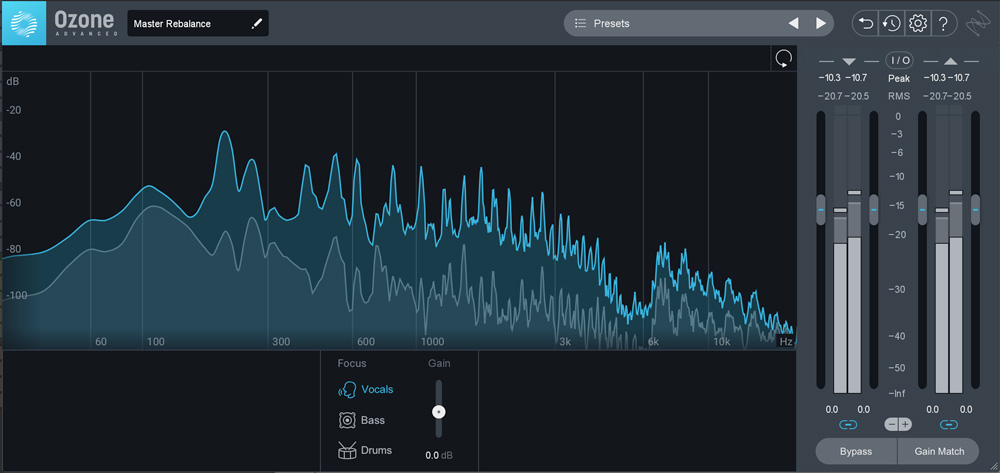
The brand-new Master Rebalance module allows us to make real-time gain changes to the Vocals, Bass, or Drums in the mastering stage without having to change levels of the individual tracks in the mix. Those level changes are accessible via a simple and slick fader which also supports automation.
Similar results like the ones from Master Rebalance in mastering have been possible before with traditional EQ & Compression techniques, but this module makes them that much easier and quicker. Its response is surprisingly accurate to the selected instrument. when used with lower to medium values the software practically leaves the surrounding instrumentation intact with no audible distortion, artifacts, or changes in tone and level.
While this tool can have obvious uses for postmortem balance corrections where a mix rebalance isn’t available there are also instances where the Master Rebalance can be useful for mix engineers. For example, in times when the client wants a quick bounce of the mix with a higher or lower vocal, Master Rebalance allows us to do just that, but quicker and easier. After the approval or disapproval of the client, the mix engineer can then disable Master Rebalance and make the corrections within the mix.
To push the algorithm of Master Rebalance to its limits we tried stacking modules one after another and boosted the vocal on maximum. Before every new instance of Master Rebalance, we lowered the output gain of the previous module to prevent unwanted distortion. The mission was to separate the vocal as much as possible from the rest of the instrumentation without altering its sound.
As expected the level of the surrounding instrumentation lowered significantly, but we now had severe audible artifacts and pumping in the lowered tracks. That being said, the vocal was almost untouched with minimal artifacts, coloration and distortion, which was impressive to say the least.
It’s All About The Bass
Getting the low end of a mix right in many genres is from upmost importance. To keep up with the demands of modern music iZotope have created a new module that helps us settle the low-end battle once and for all.
Low End focus allows us to target parts of the frequency spectrum between 20Hz and 300Hz and apply processing which can give us more definition, warmth, punch or smoothening of the bass. The two types of processing available in the module are Smooth and Punchy, and the amount of its effect on the signal is controlled with the Contrast fader.
Smooth is a subtle type of processing, which as its name suggests can help bring more clarity, warmth and definition to the lower bands of the frequency spectrum. The processing here is smoother and more forgiving with less attention being driven towards the process itself.
Punchy is the more aggressive of the two with a noticeable exaggeration of the processing that happens in the module. It seems to target the more transient prominent parts of the low- end like kicks and other percussive instruments by bringing them forward in the mix.
The rather confusing name “Contrast” starts to make sense once we start pushing its fader as it shows the ability of the module to isolate the low end of the track and alter its behavior in contrast to the rest of the instrumentation. When the fader is pushed into positive values we hear a noticeable accentuation on the desired effect, whilst negative values do exactly the opposite. For example, while positive values of the Contrast control in Punch mode can bring up the punch of a kick drum, the negative values applied on the same source will decrease its punch and transient weight.
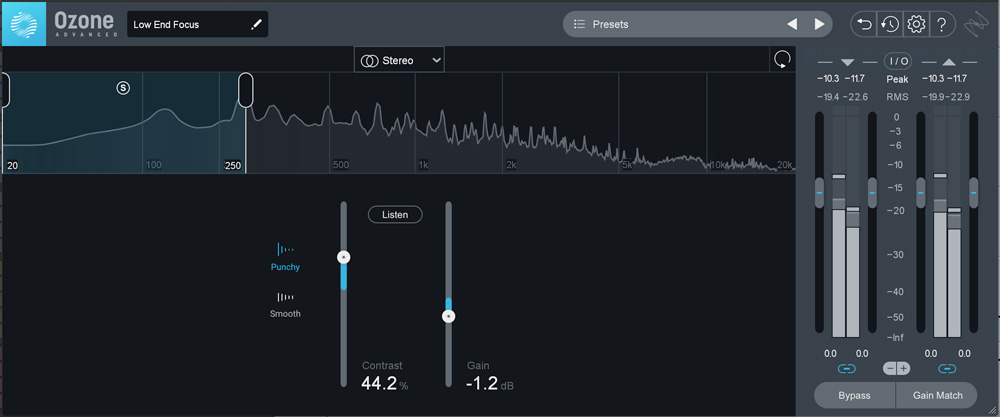
To help the overall usability and control over the module, iZotope have included a Solo button, so we can isolate and monitor the affected frequencies before any processing is applied. The Listen feature on the other hand allows us to isolate and monitor only the processing that’s taking place. For accurate gain-staging the module is also equipped an output gain control.
We asked iZotope to share some information on how this module works and what takes place within its algorithm:
“Low End Focus uses a new process iZotope developed call “Spectral Contrasting”. You can think of this as the audio equivalent of the contrast control on your TV. With your TV, the contrast control adjusts the difference between the brightest and darkest part of the image. If you imagine your audio as you see it in a spectrograph (like in RX), Low End Focus is basically doing the same thing as the contrast on your TV but within the 20-300Hz range. So it’s increasing or decreasing the difference (spectrally) between the highest and lowest level signals in that range. Using Punchy or Smooth mode allows the algorithm to prioritize short burst/transient or sustained low end event respectively.”
Much like Master Rebalance, this tool shows usefulness not only for mastering purposes but also for the mixing stages of a track. When placed at the end of a mix chain the module helps us quickly check if the low-end of our mix needs to be punchier and more focused or if it needs smoothening out. That can quickly bring low-end over-compressing issues to the surface, which can then be fixed either within the module or in the mix.
Master Assistant
Master Assistant isn’t a new feature exclusive to the Ozone 9, but iZotope have brought some major improvements to this module by adding more options for finer configuration at launch.
Whilst the Master Assistant in iZotope Ozone 8 allowed for configuration by selecting a final destination (Streaming/CD/Reference), the new and updated Master Assistant in iZotope Ozone 9 greets the user with far more options for configuration.
There are 2 options for the overall equalization and loudness modes — Modern & Vintage. Before selecting the destination (Streaming/CD) the user can also determine the intensity of the loudness & EQ processing either automatically (by loading up a reference track) or manually by choosing one of 3 available intensity settings: low, medium & high.
The brand new Vintage Mode triggers Master Assistant to load the vintage EQ, compressor and limiter modules within our mastering chain in Ozone 9. The character and coloration of those processors all contribute towards a warmer analogue-sounding master. In contrast, when Modern Mode is used, the modules chosen by the software will stir towards the cleaner and more modern-sounding ones.
Tonal Balance Control
Visually the updated version of Tonal Balance Control doesn’t bring anything new to the table, but there are some significant improvements to the versatility of that plugin. Rather than selecting 1 of 3 available modes, mark 2 of this module presents 13 new modes of operation including: Bass Heavy, Classical, Country, EDM, Folk, Hip Hop, Jazz, Modern, Orchestral, Pop, Reggae, RnB-Soul & Rock.
Another small new touch is the ability to solo the individual bands of the plugin. That allows the user to easily monitor the information of a specific frequency region which in-terms makes decision-making easier.
A major update to Tonal Balance Control allows the module to act as a mother-ship for all other iZotope EQs in a session including ones from the Neutron series. Aside from monitoring the tonal balance of a mix against the target curves set by the genre we can now open all iZotope EQs that are used within a given session and control them directly from the Tonal Balance Control module.
Price
The Standard version of Ozone 9 retails for $249, whist the one we reviewed today (Advanced) costs double the price.
iZotope have been more than generous with the sheer number of modules and expanded usability of both versions of Ozone, so whether you choose to spend $249 or $499 the fact remains that very few companies in the world would offer that much sophistication and overall bang for the buck at those prices.
And for those of us that can’t even afford the Standard version of Ozone 9, there are fantastic interest-free rent-to-own options from Splice, starting from just $9.99/moth.
Verdict
iZotopes mastering suite seems to be growing in size with every new generation. With the release of a new Ozone every 2 years we get new modules along with plenty of updates to the old ones.
Whilst Ozone 9 has introduced 2 brand-new modules, the name of the game for this update is speed and ease of use. Everything in Ozone 9 suggests that iZotope are listening to their users feedback and are making the software faster, more efficient and more powerful.
We understand some iZotope Ozone 8 users would choose to wait for Ozone 10 before updating their mastering suites, but the fact remains that Ozone 9 is an outstanding piece of software. It caters to both modern and vintage sound-seeking engineers and does its job with precision and musicality. Ozone 9 remains one of the most sophisticated mastering suits available today!
System Requirements
Operating Systems:
Mac: OS X 10.11 El Capitain–macOS 10.15 Catalina
PC: Win 7 64-bit (Latest Service Packs)–Win 10
Plugin Formats:
AAX, VST 2, VST 3, AU, NKS (All formats are 64-bit only)
Supported Hosts:
Logic Pro X, Ableton Live 9–10, Pro Tools 12.8-2019, FL Studio 20, Cubase 9–10, Nuendo 10,
Wavelab 9, Sound Forge Pro 13, Sound Forge Mac 3, Studio One 4, REAPER 5, Reason 10,
Audition CC 2019, Premiere Pro CC 2019, MASCHINE 2, Komplete Kontrol, Bitwig Studio 3,
Final Cut Pro X.


